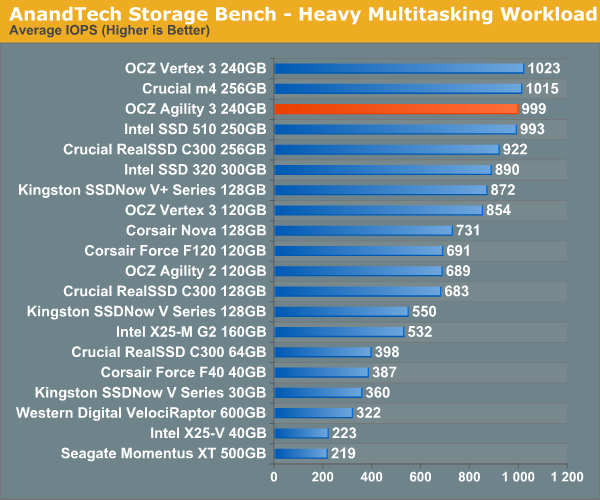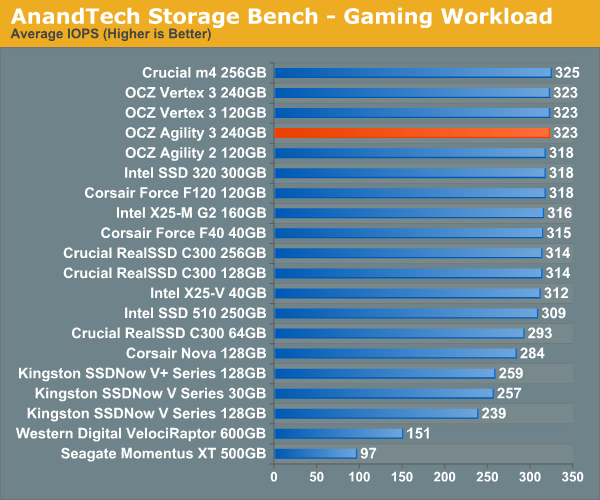OCZ Agility 3 (240GB) Review
by Anand Lal Shimpi on May 24, 2011 2:53 AM ESTAnandTech Storage Bench 2010
To keep things consistent we've also included our older Storage Bench. Note that the old storage test system doesn't have a SATA 6Gbps controller, so we only have one result for the 6Gbps drives.
The first in our benchmark suite is a light/typical usage case. The Windows 7 system is loaded with Firefox, Office 2007 and Adobe Reader among other applications. With Firefox we browse web pages like Facebook, AnandTech, Digg and other sites. Outlook is also running and we use it to check emails, create and send a message with a PDF attachment. Adobe Reader is used to view some PDFs. Excel 2007 is used to create a spreadsheet, graphs and save the document. The same goes for Word 2007. We open and step through a presentation in PowerPoint 2007 received as an email attachment before saving it to the desktop. Finally we watch a bit of a Firefly episode in Windows Media Player 11.
There’s some level of multitasking going on here but it’s not unreasonable by any means. Generally the application tasks proceed linearly, with the exception of things like web browsing which may happen in between one of the other tasks.
The recording is played back on all of our drives here today. Remember that we’re isolating disk performance, all we’re doing is playing back every single disk access that happened in that ~5 minute period of usage. The light workload is composed of 37,501 reads and 20,268 writes. Over 30% of the IOs are 4KB, 11% are 16KB, 22% are 32KB and approximately 13% are 64KB in size. Less than 30% of the operations are absolutely sequential in nature. Average queue depth is 6.09 IOs.
The performance results are reported in average I/O Operations per Second (IOPS):

If there’s a light usage case there’s bound to be a heavy one. In this test we have Microsoft Security Essentials running in the background with real time virus scanning enabled. We also perform a quick scan in the middle of the test. Firefox, Outlook, Excel, Word and Powerpoint are all used the same as they were in the light test. We add Photoshop CS4 to the mix, opening a bunch of 12MP images, editing them, then saving them as highly compressed JPGs for web publishing. Windows 7’s picture viewer is used to view a bunch of pictures on the hard drive. We use 7-zip to create and extract .7z archives. Downloading is also prominently featured in our heavy test; we download large files from the Internet during portions of the benchmark, as well as use uTorrent to grab a couple of torrents. Some of the applications in use are installed during the benchmark, Windows updates are also installed. Towards the end of the test we launch World of Warcraft, play for a few minutes, then delete the folder. This test also takes into account all of the disk accesses that happen while the OS is booting.
The benchmark is 22 minutes long and it consists of 128,895 read operations and 72,411 write operations. Roughly 44% of all IOs were sequential. Approximately 30% of all accesses were 4KB in size, 12% were 16KB in size, 14% were 32KB and 20% were 64KB. Average queue depth was 3.59.

The gaming workload is made up of 75,206 read operations and only 4,592 write operations. Only 20% of the accesses are 4KB in size, nearly 40% are 64KB and 20% are 32KB. A whopping 69% of the IOs are sequential, meaning this is predominantly a sequential read benchmark. The average queue depth is 7.76 IOs.











59 Comments
View All Comments
theagentsmith - Tuesday, May 24, 2011 - link
Corsair Force F115 154 Euros (1.34€/GB)OCZ Vertex 2E 120GB 175 Euros (1.46€/GB) don't know if it's a 25nm model
OCZ Agility 3 120GB 228 Euros (1.9€/GB)
OCZ Vertex 3 120GB 259 Euros (2.16€/GB)
Prices including VAT
Sure these new generation is faster, but there is barely any difference in a every day scenario, definitely not a night and day difference like a mechanical HD and a good SSD, so I prefer to pocket the savings to buy a F115 to another PC :)
OCedHrt - Tuesday, May 24, 2011 - link
Are the numbers in the "OCZ Vertex 3 240GB - Resiliency - AS SSD Sequential Write Speed - 6Gbps" chart on page 9 wrong? They don't match the conclusion: "The 240GB Agility 3 behaves similarly to the Vertex 3, although it does lose more ground after our little torture session."A 2-3% drop on Vertex 3 versus nearly 15% on Agility 3 is hardly behaving similarly. And the Agility 3 barely recovers after TRIM.
Mr Alpha - Tuesday, May 24, 2011 - link
For the TRIM test you fill the entire drive with incompressible randomly written data, and then TRIM it. It must take some time for the GC routine to actually clean up all those blocks. Does the time you wait before doing the after TRIM test affect the results you get?JasonInofuentes - Tuesday, May 24, 2011 - link
I think I understand what you're asking. You're wondering whether the time after the drive has been "deleted" and then left idle (for any amount of time) and thus allowed to engage in some amount of garbage collection, might be affecting the results. Certainly a possibility, which is why tests are run multiple times and averages reported.Great question, though. Thanks.
B0GiE - Tuesday, May 24, 2011 - link
I would like to see a 120Gb & 240Gb Shootout between the following:-Corsair Force Series 3
Corsair Force Series 3 GT
OCZ Vertex 3 Max IOPS
OCZ Vertex 3
OCZ Agility 3
Pretty Please!
icrf - Tuesday, May 24, 2011 - link
Agreed. I'm particularly interested in a 120 GB SSD, probably SF 2200 based. I bought an OCZ Vertex 2 @ 60G drive for boot/apps last fall, thinking I could stay within that, and have failed, so that's moved to the laptop and I'm looking for a 120G drive for the desktop.If the Corsair drives can really keep their pricing, they sound the most appealing. Specs sound very Vertex-like with pricing very Agility-like. I just want to see how some of these smaller drives fare with fewer NAND to deal with.
Oxford Guy - Tuesday, May 24, 2011 - link
The 240 GB Vertex 2!Shadowmaster625 - Tuesday, May 24, 2011 - link
"The original X25-M had 10 channels of NAND, giving it the ability to push nearly 800MB/s of data. Of course we never saw such speeds, as it's only one thing to read a few KB of data from a NAND array and dump it into a register. It's another thing entirely to transfer that data over an interface to the host controller."That's why I been saying they need to put a flash controller on the die. Imagine a dual sided DIMM with 8 NAND chips per side, each running ONFi 3.0 400MB/s. That's 6.4 GBps. zomg. It illicits a pavlovian response. 50 billion bits per second?
If intel was really interested in capturing the portable devices market, they'd be doing this. The tablet and smartphone SoCs all have integrated lpddr controllers, and look how fast they are for being such low bandwidth and low power.
bji - Tuesday, May 24, 2011 - link
I wonder if it's practical to put the controller on the die. Flash dies are highly optimized for flash, not general purpose processing transistors. Flash is usually a generation or so ahead of CPUs in the lithography process used because flash is simpler in its layout than CPUs. Putting a controller on a flash die would imply using the same lithography processes used for flash to be used for processing transistors and I just don't think that's likely to be feasable. Of course, flash controller logic would likely be alot simpler than a full x86 core. But I don't think that changes the fundamental impracticality of using flash process technology to create controller logic.bji - Tuesday, May 24, 2011 - link
Oh sorry I think I misunderstood you. You're talking about putting flash controllers on CPU dies, not on the flash dies, I think. In that case, I think that it's likely to be an inevitability. I predict that eventually permanent storage will look like DIMMs do now, like you said as sticks that you plug into slots in your motherboard just like you do for RAM now, and the controller will be built into the CPU to interface with them at high speed and operating systems will just see them as mapped to some memory range in the CPU address space. "Hard drives" will be a thing of the past, replaced by 'persistent memory'.